#ojibwe florals
Explore tagged Tumblr posts
Text










All of the drums I have painted so far 🪶✨
🖤❤️💛🤍
#art#artwork#indigenous#indigenous art#painting#first nations#First Nations art#ojibwe#ojibwe florals#7 teachings#eagle#my art
22 notes
·
View notes
Text

Christian Allaire at the Met Gala 2024, wearing custom outfit by Jamie Okuma.
Allaire, a fashion writer at US Vogue, is Ojibwe, and a member of the Nipissing First Nation, Ontario. Okuma is a Luiseno, Shoshone-Bannock, Wailaki, and Okinawan who is also an enrolled member of the La Jolla band of Indians in Southern California where she lives and works.


Allaire: 'I knew I wanted to wear an Indigenous designer to the Met this year. When I heard this year’s theme—“Sleeping Beauties”—and dress code—“The Garden of Time”—I was instantly struck by a few concepts: That our Indigenous designs & craftwork have persisted FOREVER, and that many of our traditional garments have always beautifully reflected the natural world that surrounds us.
On the blazer,��@j.okuma used a hand-reverse appliqué method to illustrate two of my favorite flowers from back home: Lupines and Indian Paintbrushes. Turns out, these flowers are also popular in Jamie’s region down on the West Coast. (We both agreed they are very “rezzy flowers.” 😉) For the pants, Jamie also put a contemporary twist on a traditional breechcloth, instead adding a built-in panel to formal tailoring. I absolutely adore how she mixed the old with the new.
To finish off the look, Jamie also surprised me with a special Bandolier-style bag that made me super emotional when I unboxed it. She found an ANTIQUE piece of Ojibwe floral beadwork (likely turn of the century) to represent my specific heritage, and then helped restore it into a cross-body style—adding modern touches like crystal straps and ribbon embellishments.
Many archival photos show Ojibwe men wearing similar Bandolier bags throughout history, and when I carried it last night, I couldn’t help but feel like I was carrying a piece of my ancestors with me. And holllah - we made it to the MET.'
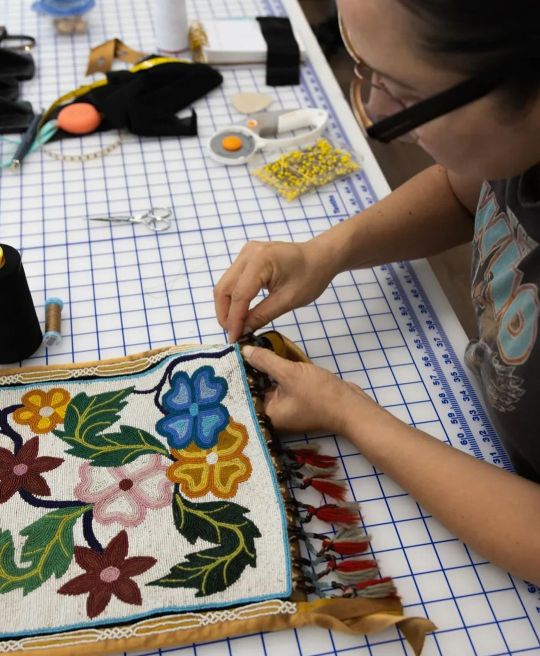
#christian allaire#met gala 2024#met gala#red carpet#fashion#indigenous designer#indigenous fashion#the garden of time#j.okuma#jamie okuma#applique#surface pattern#surface pattern design#pattern#pattern design#textiles#beadwork#beading#2024#ojibwe#flowers#floral#lupin#indian paintbrush#first nations#traditional dress#traditional craft#breechcloth#bandolier#bag
53 notes
·
View notes
Text
oc introduction: SilentDove Reyes



"It was my father who gifted me my name, y'know. He claims that, when I was born, I was silent. Him, my mother, my kokom, and the midwife thought I was a stillborn. They feared the worse. Guess I'm just naturally dramatic."
paloma (masterlist)

name: silentdove marie reyes.
age: 22 [july 13th, 2001].
pronouns: she/her.
gender: cisgender [female].
birthplace: near box elder, montana.
race: native american & hispanic.
nationality: american.
tribal affiliation: the chippewa-cree tribe of the rocky boy indian reservation.
occupation:
cryptological language analyst.
(milf-in-training) wife of simon riley.
languages: nēhiyawēwin, spanish, portuguese, russian, and french.
face claim: tanaya beatty

playlist.
electric pow wow drum — the halluci nation.
edge of seventeen — stevie nicks.
one woman army — porcelain black.
you driving me crazy (indian girl) — joey stylez, northern cree.
boss bitch — doja cat.
mother's daughter — miley cyrus.
celestial bodies — semiah.
mayores — becky g, bad bunny.

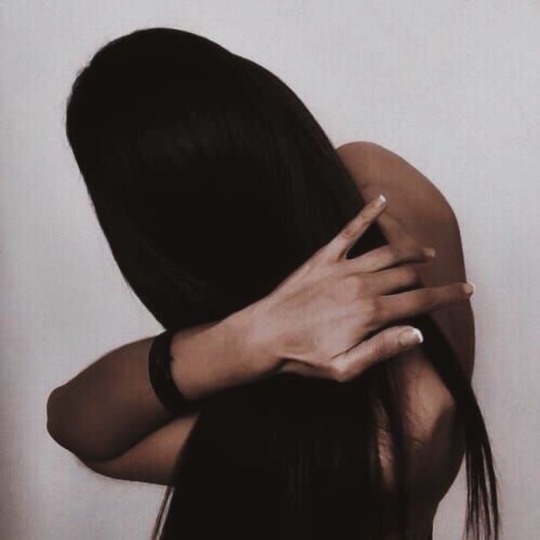


additional facts below the cut.
— dove is hispanic and lipan apache through her father. on her paternal grandfather's side, she traces her heritage to guerrero viejo, tamaulipas, mexico.
— through her mother, she has connections to the sweetgrass cree first nation located within treaty 6 territory.
— blessed with a learning tongue, she is a polyglot. her first languages consisted of a blend between nēhiyawēwin (the plains cree language), spanish, and english. during high school, she took on russian and french as a challenge, and later portuguese.
— on her right bicep is a traditional ojibwe floral design depicting bright orange tulips.
— she'll never kill a spider. in her mind, she recites the following: "if i am killed for simply living, let death be kinder than man."
— greatly enjoys the following:
contemporary jingle & old style fancy
ribbon skirts
ear piercings
beading
long distance runs
corridos
vines
scented creams & lip-glosses from bath and bodyworks.

notes: hopefully y'all find enjoyment in my dove :D with this now out of the way, i'll begin the main writing portion of the series <3
#silentdove r.#paloma series#call of duty#call of duty modern warfare#cod mw#cod mw2#cod mw3#call of duty oc#cod oc#simon riley#simon ghost riley#cod ghost#simon ghost riley x ofc#simon riley x oc#ghost x oc#orginal character#vic writes 🧸
50 notes
·
View notes
Text
Aanii it my first time posting on here
This week I made some thank you cards and wanted to share them with everyone. All of the animals are native to Canada, and I decided to add some Ojibwe florals and medicines. The animals I drew are
Hare
Grizzly bear
Canada lynx
Grey wolf
And a golden eagle





#indigenous art#indigenous artists#indigenous#artwork#artists on tumblr#original art#traditional art
4 notes
·
View notes
Text

Pair of beaded moccasins, son sole seamed toe, and floral beaded cuffs
ca 1920 #Ojibwe
2 notes
·
View notes
Text
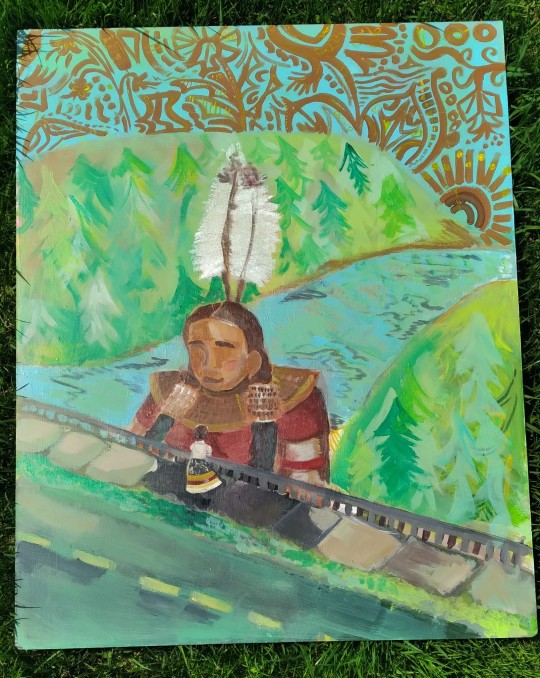
Meeting The River Acrylic on panel
Crossing a bridge on the way home I felt small. Not small insignificant, but small the way one tile is in a mosaic, surrounded by others. That feeling became this, a painting I altered about three times as of now.
The pattern in the sky is inspired by woodland ojibwe florals.
4 notes
·
View notes
Text
I Am YEG Arts: Heather Shillinglaw

Mixed media artist Heather Shillinglaw expresses her Indigeneity and familial oral histories through collages that employ sewing, painting, and sculpture methods. She grew up in Ministik near Cooking Lake and now lives in Edmonton and has a strong connection to the land and to her heritage; Nêhiyawêwin /Cree, Dene/Chipewyan, Salteaux/Ojibwe, and Scots/French. Over the course of her career, she has shared land-based teachings in art workshops with thousands of students of all ages, taken on activist work to highlight the importance of the natural world to inspire others to preserve what is left, and has exhibited her work extensively. In this week’s I Am YEG Arts feature, we get to know more about Heather Shillinglaw.
Tell us about your connection to Edmonton and why you've decided to make it your home.
Growing up outside of Edmonton, we would come into town to do our shopping, and all that kind of stuff. And I always thought it was so fancy, and a fantastic place to live with all these great shops and beautiful river valley to pick berries or whatever. It maintained a consistent interest for me to live here and settle here. Now that I have my family, my husband and my two daughters, we call it home. And it's not far from the place where I grew up, and my family. So, we're kind of surrounded within Edmonton. I also have an ancestral connection to the land in that they harvested medicines, mostly berries here, which I'm very glad to say that saskatoons grow prevalently in our River Valley.
What is your creative process like? And what motivates you as an artist?
I started out mostly as a mixed media artist, project based, so when I make art, I'm very material based. There's kind of a relationship with the material that I start building a language within the work I'm creating. It's either through symbolism, the materials, or the project base -- the goal -- which is talking about the environment, preservation of what's left, to creation of the piece itself. Right now, I'm obsessed with sewing, and I'm sewing on hides and then I'm sewing on big florals. I collect and harvest like a mouse. That's my animal spirit and I see things large and giant, and I'm very humbled by the land.
In my pieces I’m using anywhere from three to six different types of sewing machines to create the work. When I'm sewing, I'm thinking about that kinship and relationship to the landscapes, like the maternal landscapes. It's all nature based and it's all about the healing plants and medicines that are in our land.
How do you choose the materials you work with?
That's a tricky one because I'm constantly collecting like a mouse. Another aspect in thinking about conservation of our land and not causing problems, I use a lot of recycled materials and mediums. In the body of work that I'm still creating, ᒫᒥᑐᓀᔨᐦᒋᑲᐣ ᑯᑖᐄᐧᐤ mâmitonêyihcikan kotâwîw, – my mind digs in the soil like a turtle -- an exhibition that's happening right now in Halifax at the Mary Black Gallery -- I'm sewing on to hides and it's kind of an eagle eye’s perspective. Through that I'm doing tufting, beading, and sewing into bodies of water that relate to the landscapes of where my ancestors hunted and harvested. Inspiration sources come from here, there and everywhere. So, you know, I'm a mouse that acts like a magpie.

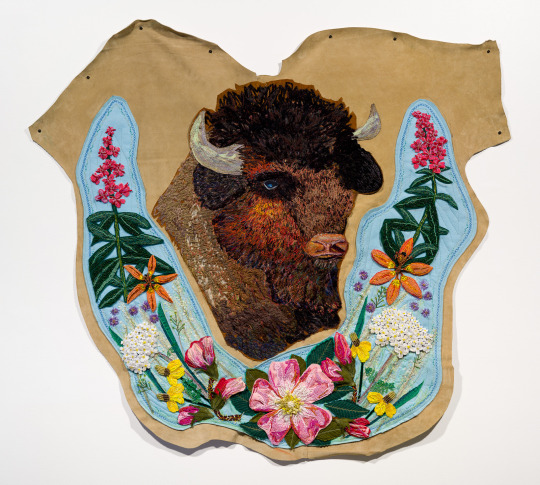
Top: Detail of ᑮᓯᑌᐳᐃᐧᐣ ᓵᑳᐦᐃᑲᐣ kîsitêpowin sâkâhikan cooking lake by Heather Shillinglaw. Bottom: Gravemarker Bison from the Whiskey Script Series by Heather Shillinglaw.
Where does your inspiration come from?
The inspiration comes from the land itself. For a lot of my projects, my inspiration source is my mother: through storytelling about the land, and her memories from our Nohkums, our grandmothers, and how they harvested from the land, right down to the specific berries, or the relationship that the moths share with the trees and how it provides a kinship relationship to the land itself. Then through that, I'm taking oral stories and I'm also looking at other forms of research, such as archival research. I've worked with ethnographer Ruth McConnell and I've been working with Elder and Knowledge Keeper Lynn Desjalais/Lush from the Sandy Bay Reserve (she's a relative of ours, I think that's an added bonus). And Anne Cardinal, who's from Saddle Lake Reserve. There's a cultural connection, an artistic connection, a research base. So, there's many different platforms in my resources and where I make my art from.
Marilyn Dumont is another source of inspiration. Marilyn is a Métis poet, and we share common lineages in where our inspiration sources come from. I've been sewing her poetry into bodies of water, and I sew my own poetry now because she's given me a lot of strength to do that. So that's another aspect of my work – using poetry and prose to talk about what's going on in the art. I'm so honoured that she said she's willing to work with me and we continue to work together on projects.
You've had the opportunity to exhibit your work nationally and internationally as well as participate in residencies abroad in Paraguay and Argentina. How was your artistic practice influenced by these cultural exchanges and how was your work received?
That was so much fun. 2009 was a bit of a banner year for me. Beatriz Ventura , who is the Canadian consulate located in Buenos Aires, for Argentina and Paraguay, connected with me and we talked about medicines, and she talked about her ancestors and how they hunted and harvested. Through that I sat on panel discussions, I exhibited my work, and then I did a little bit of a residency. I was quite excited and engaged by what was happening with the Indigenous people out there and how it was almost like going back 200 years for their discovery of the oil rights in the land. I gave some advice, from my ancestors and their trauma and problems that we've had in the past. I got invited to go around with an anthropologist in Mendoza and she took me up into the mountains, and we met the Indigenous tribes there. It was a phenomenal experience.
The more I thought about it, the more I wanted to talk about plant sustainability, which is in my practice today. Then I got invited by a conference attendee from Paraguay, Asunción to stay in her home. I got a chance to meet all these wonderful people there, networked with them, created workshops for the conference that I attended, gave a panel discussion presentation of my work, and then I also got a chance to work with the UNICEF school out there as well. I kind of became a little bit of a political activist. I'm not in your face in my politics; there are political statements within the art itself. And the more I create my work, the more I'm concerned about the land and preservation, because our oil and gas industry is affecting our water tables, it's in our system and there's some relationships of what Industry Canada is doing to our land that is very disconcerting. As an artist, your job and your role is to make sure you carry your message through your art, so that's where art becomes an activist statement. And I don't want to be in your face. I want people to want to understand. And that's where you can access more of a deeper, profound way of understanding the art, understanding culture, and understanding our planet and preservation.

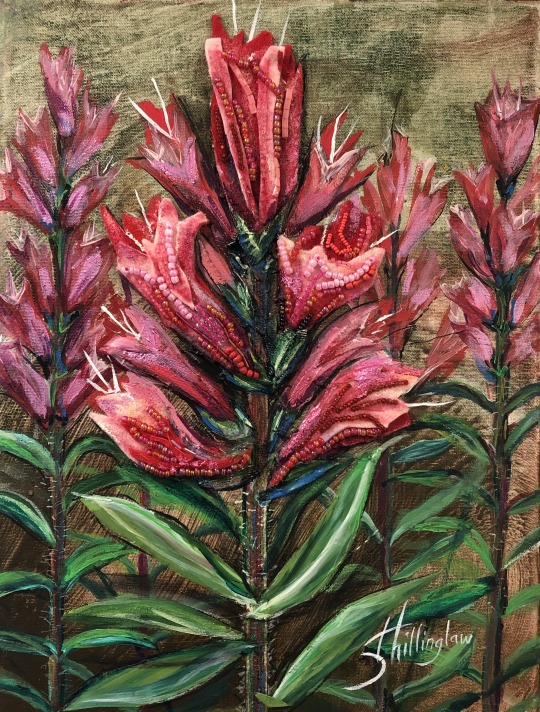
Top: Gravemarker Fox from the Whiskey Script Series by Heather Shillinglaw. Bottom: Painted Red by Heather Shillinglaw.
What would you say is your greatest strength as a creative?
I have taught many artists and residencies over the years, and I worked at the Art Gallery of St Albert as their first Indigenous Visual Arts Programmer; I take pride in that. Whenever I'm teaching, I take it upon myself to inspire people. That’s important and supports my practice. That's another hat that I wear as an artist. Through my Elders, I've learned that a big part of our culture is sharing, and you share with humility. Like, the information that was given to me, you hand it down for the next generation to inspire them. And they're probably not going to make the same work that you're going to make; the goal is to inspire, and that’s why I teach.
Tell us a little bit about what you're currently working on or hoping to explore next.
At the Centre of Contemporary Craft of Nova Scotia there is an exhibition of my work right now, it closes on July 2nd. I will be going to see the exhibit and attend a series of things going on out there. It’s a body of work called ᒫᒥᑐᓀᔨᐦᒋᑲᐣ ᑯᑖᐄᐧᐤ mâmitonêyihcikan kotâwîw, – my mind digs in the soil like a turtle, and it's basically large landscapes and a body of work that showed here last year at the Alberta Craft Council. It does come back here in the fall, in September and October at the Art Gallery of St Albert. We're going to be doing some exciting activities, workshops and talks.
In January, I have an exhibition at the McMullen gallery. I'm going to be doing some workshops and artist talks and events. And as a sneak peek, for Gaagige Giizhig - Ishpeming (Forever Sky) (the Sky Above) I'm going to be turning the gallery to space! Those are works are on black panels, and there's thirteen of them, and they're not small either -- some of those panels are larger than me, so maybe like 8' x 5’ ft. MSHKAWJI GIIZIS (FREEZING MOON) – OCTOBER for example, is one of them, it’s the frost moon, so they're really different.
And then I have another body of work, it's called Whispers in the Forest, and it's going to the Esplanade Gallery [in Medicine Hat]. It's part of a larger group exhibition. In 2026, I have a solo exhibition at the same gallery and I'm just working through that. I'm going to be focusing on learning ancestral languages from language keepers: Saulteaux Denesuline language, Anishinaabe language, and Nêhiyawêwin Cree. It's going to be a massive mouse trap, a life-size mouse trap that focuses on live, eat, sleep, repeat.

Detail of MNIDO GIIZIS (SPIRIT MOON) – JANUARY by Heather Shillinglaw.
Tell us about a local artist group or organization that is doing great work in the community that you think more people should know about.
I would start off by saying CARFAC Alberta is fantastic and great to work with because they do a lot of programming to help artists survive as artists. There's a lot of versatility in the art world, but it's challenging to survive as an artist. They do all kinds of workshops to help people, anywhere from writing grants, to what's next, or how to ship your art internationally and that sort of thing. So, there's lots of opportunities for artists to learn from them.
And then I would say the Art Gallery of Alberta is fantastic. I’ve shown my work there, I sell my work at the art rental sales, and I've had opportunities to work with them and be a special guest artist, teaching workshops for them that a benefactor had paid for. There are phenomenal opportunities for artists to connect with them. Outside of that, there is the Art Gallery of St Albert. Emily Baker and Leah Louden are fantastic. They also sell my work out there, and they do amazing programming that is so unique. You can go in by donation and still access a lot of the arts just in that space itself. So those are some really good places that do so much in the community.
The Rowles and Company Gallery also sells my work. I'm saying support our local galleries because you know, they really struggled to get through COVID, so it's really important to share that message with others.
And I didn't even mention the Edmonton Arts Council, that they offer so much programming, so many grants and possibilities for artists themselves. I've been honored to be a recipient of those grants and organizations for money to create my works.
I am also so thankful that I have been inspired by Shirley Norris Shillinglaw, who's my mother, and my family that supports me. Keith Macmillan and my daughters tolerate bits of thread and my messy nature. They’ve been very generous to allow me to do that.
About Heather Shillinglaw
Heather Shillinglaw is a project-based artist adapting art materials using sewing, painting and sculpture methods. Growing up in Ministik near Cooking Lake, she now lives in Edmonton, Alberta. Shillinglaw is proud of her heritage; Nêhiyawêwin /Cree, Dene/Chipewyan, Salteaux/Ojibwe, and Scots/French. Shillinglaw shares land-based teachings in art workshops to thousands of students of all ages, throughout her career. She becomes an activist, her voice in sharing through art she hopes to inspire the importance of the natural world to inspire preserving what is left. Exhibiting her work nationally and internationally, she is humble in acknowledging the awards and Grants that help her projects, inclusive of a recent award Leighton Studio stay at the Banff Center for the Arts; the Gerin-Lajoie Studio. Previous exchanges abroad in Paraguay and Argentina working with anthropologists, medicine women of Tobian- Guarani and Mapuche healers in South America, and other shows/cultural connections abroad. You can learn more about Heather here.
3 notes
·
View notes
Text

ajijaak (crane)
321 notes
·
View notes
Photo



The Mother Bear Card is now available in my shop - a collaboration between me and the talented ojibwe artist Baapi Makwa @baapi-makwa. It's a hand-made card for mother's day, including a poem and handmade envelope. Only 10 will be sold, so it's an extra special gift.
#mothers day#mama bear#collaboration#handmade cards#native american art#ojibwe#kirigami#papercutting#mom#gifts for mom#bear#cards#Artistsontumblr#floral art#gift cards
146 notes
·
View notes
Text
With you IG @ARTBY_HZ

#indigenous#floral#digital drawing#canada#nativeamerican#ontario#ojibwe#couple#love#hold me#first nations#native art
82 notes
·
View notes
Photo

#Indigenizing the Oval Office#All My Relations Gallery#Native America#Free the Slave Slay the Free#Ojibwe floral rug#Minneapolis#Minnesota
0 notes
Note
to be fair, while orville should make an apology, isnt it likely the photographer for the shoot who is at fault for stealing native art? in the industry, generally it’s the photographer and their team who direct a shoot. orville signed off on it of course, but it’s likely he was ignorant of the original going into the shoot
The photographer could definitely be responsible, at least in part. But Orville is a white dude adopting the "cowboy" style, which already takes a lot of influence from & appropriates from ndn fashion and culture. Even the fringe on his mask is obviously a call back to the Native tradition in fashion of fringing our leather clothes, that didn't come from nowhere. You also see him do this in some of the other clothes he wears, like this photo with a fringed leather vest with Navajo "inspired" metalwork embelleshments

, this photo of pants that is, again, leather and fringed (& with a vest that seems to be Native art inspired)

arguably this photo of him where he braided the fringes on his mask to resemble hair braids (I'm not saying ndns are the only ppl who culturally have this hairstyle but you can't deny its heavy association with Native men)

or here where his shirt takes inspo from beaded leather clothing, especially something like Ojibwe floral beadwork (like, compare it to this traditional Ojibwe shirt)


So like, maybe it is the photographer yeah. But white cowboys are already on thin fucking ice in terms of the appropriation department, and he should be more careful with that, but even without the photo he's been stealing ndn shit. He shouldve known that him as a white settler Canadian that him proudly carrying a Bison skull has some uh. Baggage. He should've known better
901 notes
·
View notes
Photo

Great Water Hoodie from House of Howes.
Ok I’m posting this even though I can’t even think of getting one yet because this is really fucking cool and House of Howes needs to not be left out of peoples “buy Native” list coz Sarah Agaton Howes is AMAZING.
#buy native#ojibwe#house of howes#fashion#indigenous designers#woodland floral power#indigenous fashion
22 notes
·
View notes
Photo








sometimes i wish i spoke no English at all. on Indigenous anger and languages:
"red language" heid e. erdrich // “devils language” marilyn dumont // the chase kent monkman // “the disconnection” clark douglas // braiding sweetgrass robin wall kimmerer // "the word for gossip" eric gansworth // honouring my spirit helpers christi belcourt // “dear new blood” mark turcotte
image description:
image 1: an excerpt from the poem “red language” by Ojibwe poet heid e. erdrich, reading: “offer my own red language / my tongue to your tongue / so we recall what we once said / that made us live.”
image 2: an excerpt from the poem “devils language” by Métis poet marilyn dumont, reading “the Great White way could silence us all / if we let it / its had its hand over my mouth since my first day of school / since Dick and Jane, ABC's and fingernail checks / syntactic laws: use the wrong order or / register and you're a dumb Indian / dumb, drunk or violent”
image 3: a painting by Cree artist kent monkman, where bison in different styles of painting run down a city street. A Native man with bow and arrow hunts them, riding his motorcycle like a horse.
image 4: an excerpt from the poem “the disconnection,” by me, reading: “if I say it enough,/ will they remember these words too? /will the muscle memory of cree come back into us, shift our tongues just right, / will the fog of being colonized fade, will it be gone / just like that?”
image 5: a quote from the book braiding sweetgrass by citizen potawatomi writer, robin wall kimmerer, reading “In some Native languages the term for plant translates to ‘those who take care of us.’”
image 5: an excerpt from the poem “the word for gossip” by Haudenosaunee poet eric gansworth, reading: “In English, you want to say “I heard” / and not “They say,” and if you don’t / understand the importance of that / difference, it is good that we travel / our parallel paths, crossing only in / the wake we leave to dissipate behind us.”
image 6: a painting by Métis artist Christi Belcourt, in the floral style of traditional Métis beadwork. everything is connected, from flowers to roots to animals.
image 7: an excerpt from the poem “dear new blood” by Anishinaabe poet mark turcotte, reading: “Mourn. I think you, / too, were born with broken heart. / Rise. Smash your un-American throat / against the edge of the sky.”
#web weaving#webweaving#parallels#ndn#yes i included an excerpt from my own poetry what about it#indigenous#mine
275 notes
·
View notes
Note
are those bear drawing you are reblogging a closed style? are they a specific culture? theyre really cute, could a white person draw that style too?
Those drawings were done by the marvelous Ojibwe artist @baapi-makwa and are certainly culturally inspired. In the past they were open to (some of) their art being used under certain circumstances, but as you can no longer ask them, I would advise folks simply don't.
While not all of their art consists of technically "closed" designs, if you are a white person, I would suggest looking into the floral styles of European folk art for inspiration as these would be more suiting, less appropriative, and also thematic of animal + floral.
Thanks for asking and I hope you find my suggestion helpful!
12 notes
·
View notes
Photo
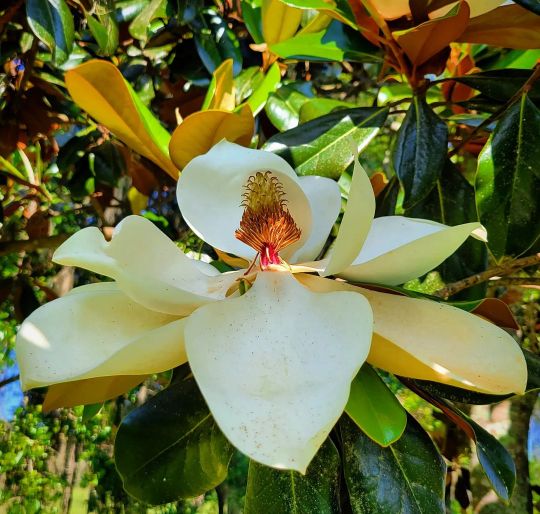
Ms. Pakanli Kohlaha (Flower of the Magnolia, Choctaw) once again flourishes her shining golden crest, as she and her ancestors have done upon these lands every Ama Ganugogv (Springtime, Cherokee), for 15 thousand years. Shine on, Waabigwani-Giizis (Flower Moon, Ojibwe). ♡♡♡ #magnolia #ancienttrees #indigenous #treeflowers #flowersinurbia #flowers #floral #flora #fleur #nature #fleuriste #fleuris #naturelovers #naturephotography (at Miccosukee Canopy Road Greenway) https://www.instagram.com/p/Cdlt0mDL6Ci/?igshid=NGJjMDIxMWI=
#magnolia#ancienttrees#indigenous#treeflowers#flowersinurbia#flowers#floral#flora#fleur#nature#fleuriste#fleuris#naturelovers#naturephotography
11 notes
·
View notes